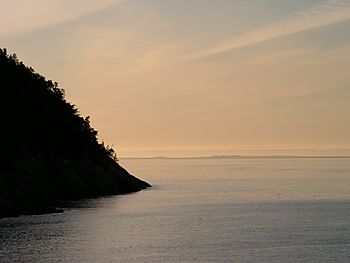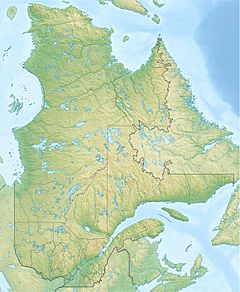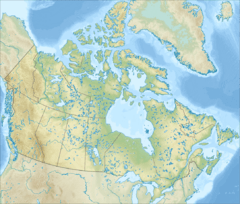Estuary of St. Lawrence facts for kids
Quick facts for kids Saint Lawrence Estuary |
|
|---|---|

Estuary of Saint-Laurent at Port-au-Saumon (Quebec).
|
|
| Other name(s) | Estuaire du Saint-Laurent (in French) |
| Country | Canada |
| Province | Quebec |
| Physical characteristics | |
| Main source | Saint Lawrence River Lake Saint-Pierre, Trois-Rivières, Quebec, Canada 46°16′17″N 72°38′5″W / 46.27139°N 72.63472°W |
| River mouth | Gulf of St. Lawrence / Atlantic Ocean Pointe-des-Monts, Quebec, Canada 0 m (0 ft) 49°08′N 67°14′W / 49.133°N 67.233°W |
The Saint Lawrence Estuary in Quebec, Canada, is one of the biggest estuaries in the world. An estuary is a special place where a river meets the sea. Here, the fresh water from the Saint Lawrence River mixes with the salty water from the Atlantic Ocean.
Contents
Where is the Saint Lawrence Estuary?
The Saint Lawrence Estuary is found where the Saint Lawrence River flows into the Gulf of St. Lawrence. It's like a giant mixing bowl for fresh and salt water. This amazing area starts at Lake Saint-Pierre. It stretches all the way to where the shores get much wider, near Pointe-des-Monts, Quebec. This is across from Les Méchins, Quebec.
Sections of the Estuary
The Saint Lawrence Estuary is divided into three main parts:
- River Estuary: This part is near Île d'Orléans (Orleans Island). It's where the first mixing of fresh and salt water begins.
- Middle Estuary: This section goes up to the Saguenay River. The water here becomes more salty.
- Maritime Estuary: This is the widest part. It extends to Pointe-des-Monts, Quebec, and is very salty, almost like the ocean.
The Mixing Zone
A special feature of the estuary is the "saline front." This is where the fresh river water first meets the salty ocean water. This meeting point creates a cloudy area called the "zone of maximum turbidity" (MTZ). It can be anywhere from 70 to 120 kilometers (about 43 to 75 miles) long. The length changes depending on how much water the river is carrying.
This cloudy zone is important for many young fish. It gives them a safe place to grow, hiding them from predators. The water conditions here, like temperature and saltiness, are just right for baby fish. This area is a busy nursery for many different kinds of fish.
Animals and Plants
The Saint Lawrence Estuary is home to many amazing creatures. One of the most famous is the beluga whale, known for its white skin. But there are many other species living here too. Scientists did a full count of all the fish in the estuary in 2008. They found a wide variety of fish species. The special mixing of waters and the cloudy areas help support this rich animal life.
See also
 In Spanish: Estuario del San Lorenzo para niños
In Spanish: Estuario del San Lorenzo para niños



